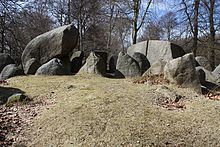Halskov Vænge
In the forest of Halskov Vænge near Bregninge ( Horbelev Sogn ) on the Danish island of Falster , many burial mounds and dolmens from prehistoric times have been preserved. Six barrows from the Neolithic Age , 72 Bronze Age burial mounds, a shell stone , a medieval ravine (Hulvej) and a wide old border wall are located in the protected area of 29 hectares, which has been expanded several times.
A marked hiking trail leads from the parking lot on Strandhuse (street) to the 14 most important monuments. In the forest there is also the “Egevængehus”, a small museum with exhibitions and pictures that tell the story of the landscape. The state acquired the forest, devastated by severe storms in 1967, in 1974 to preserve the prehistoric and historical remains. The oldest systems were built in the Neolithic between 3500 and 2800 BC. BC as a barrow of the funnel cup culture (TBK). These monuments are an expression of the culture and ideology of Neolithic societies. Their origin and function are considered to be the hallmarks of social development.
description
The six Neolithic megalithic sites in Halskov Vænge are:
- two relatively preserved long dolmen
- a well-preserved or restored long dolmen,
- a very disturbed long dolmen,
- a halfway intact round dolmen; these three plants are roughly in a row, as well
- an isolated long dolmen.
- Outside the forest, near the road, continuing the row, lie the chamber and some curbs of a round dolmen.
In the Bronze Age burial mounds were created here as burial places. One of the Bronze Age hills has been excavated. It contained three cremation graves and a bronze knife. 45 hills have visible curbs that were restored during restorations. Another 29 small mounds have also been restored. There is no reason to believe that Halskov Vænge had more burial mounds than anywhere else. The only difference is that they are better preserved in the forest than in the open landscape, where they have been eroded by industrial agriculture, wind and weather.
The approximately 4.2 m long, 3.8 m wide and 2.5 m high Spejdersten , near Halskovgård Sten , is Falster's largest boulder . He carries two bowls , but their function is not known. According to an old popular belief, the stone turns when it smells freshly baked bread somewhere. This popular belief is widespread in Denmark. Another stone (in Nørreskoven) is known under the name Spejderstein.
A ravine that is no longer used today was created through centuries of use of a path between Halskov and Bregninge.
See also
literature
- Karsten Kjer Michaelsen: Politikens bog om Danmarks oldtid (= Politikens håndbøger. ). Politiken, Copenhagen 2002, ISBN 87-567-6458-8 , p. 209
Individual evidence
- ^ Johannes Müller : Neolithic Monuments and Neolithic Societies. In: Hans-Jürgen Beier , Erich Claßen, Thomas Doppler, Britta Ramminger (eds.): Varia neolithica VI. Neolithic Monuments and Neolithic Societies. Contributions from the meeting of the Neolithic Working Group during the annual meeting of the North-West German Association for Ancient Research in Schleswig, 9. – 10. October 2007 (= contributions to the prehistory and early history of Central Europe. Vol. 56). Beier & Beran, Langenweißbach 2009, ISBN 978-3-941171-28-2 , pp. 7-16, here p. 15.
- ↑ (Danish: Langdysser) is the common denomination in Denmark for dolmens that lie in a rectangular or trapezoidal barn bed, in contrast to this, round dolmen or Runddysser are those dolmens that lie in a round hill
Web links
Coordinates: 54 ° 48 ′ 5 ″ N , 12 ° 5 ′ 4 ″ E


